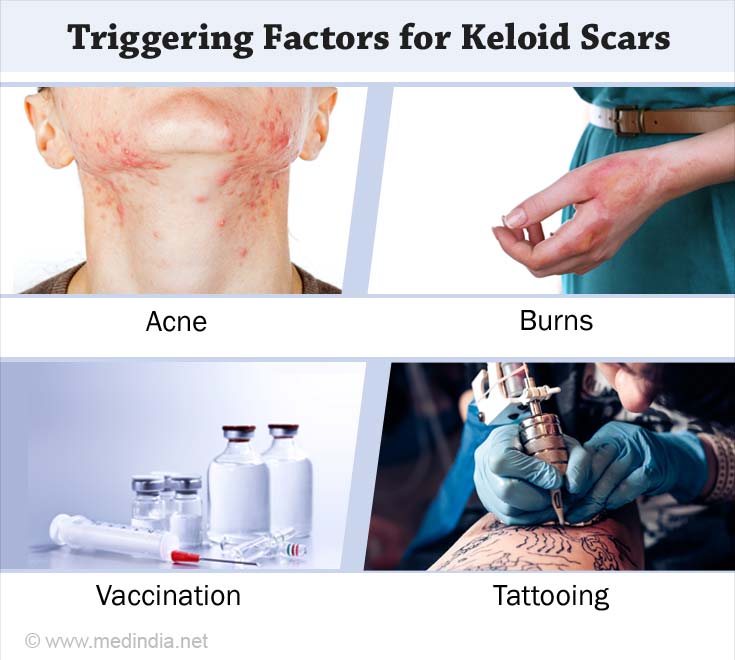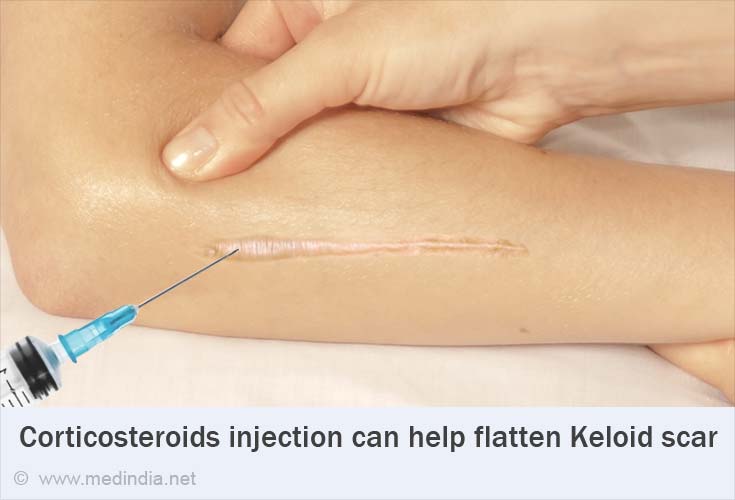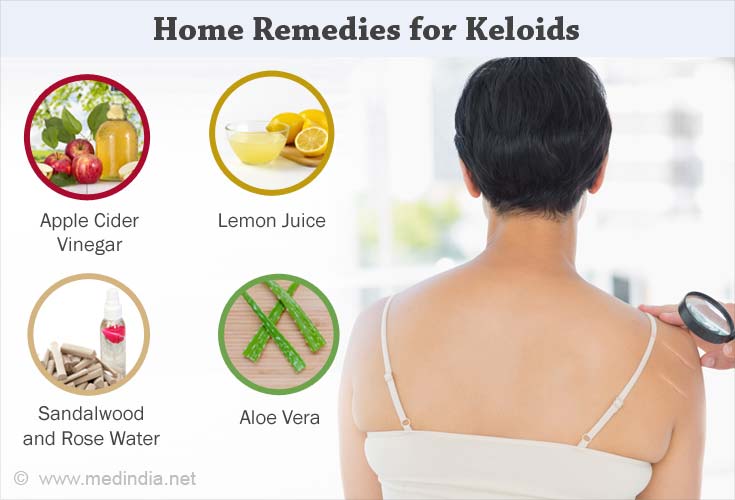- Keloids - (https://medlineplus.gov/ency/article/000849.htm)
- Management of Keloids and Hypertrophic Scars - (http://www.aafp.org/afp/2009/0801/p253.html)
What are Keloid Scars?
Keloid scars are shiny, hairless, hard, and rubbery scars that grow beyond the wound into the healthy skin. Though they appear large, they are not contagious or cancerous.
When there is a cut, bite, scratch, burn, or acne, the body produces a structural protein called collagen which forms a scar. The scar pales off after some time as the wound heals. But some scars grow further invading healthy skin and becomes bigger than the original wound. These are known as keloid scars. Keloids take three months or even years to develop.
What are the Causes of Keloid Scars?
Keloid scars are elevated surfaces of extra collagen that occur after skin injuries. Hence, any kind of injury to the skin might cause a keloid scar.
Keloids are most common in individuals of the age 10 to 20 years, and are mostly seen in African Americans, Asians, and Hispanics. They usually occur in darker-skinned individuals. Below are some of the pre-disposing events prior to a keloid scar:
- Acne
- Burns
- Chickenpox
- Vaccination
- Ear piercing
- Tattooing
- Cuts from surgery or trauma

What are the Symptoms and Signs of Keloids?
Keloids are flesh-colored, red, or pink scars located over the site of an injury. They are most commonly seen in the upper chest over the breastbone, shoulders, on the earlobes, cheeks, and neck. The keloid tans darker than the skin adjacent to it if exposed to sun during the first year of its formation. Its surface is shiny, hairless, jumpy or rigid, and itchy at times. It may become irritated from friction such as rubbing on clothing. A keloid over a joint can cause limitation of movement of the joint. Some people may be distressed by the cosmetic disfigurement caused by the keloid.
How do you Diagnose Keloids?
Keloids are detected by a visual examination. A skin biopsy may be performed to rule out other types of skin growth including skin.
How do you Treat Keloid Scars?
Treatments for keloid scars include steroid injections, steroid-impregnated tape for 12 hours a day, and silicone gel sheeting for several months. Furthermore, cryotherapy is also performed, wherein keloids are frozen using liquid nitrogen. Finally, laser treatment is used to reduce the redness. Surgery for removal of the scar can be followed by treatments which include.
Corticosteroid injections
Corticosteroids suppress inflammation and multiplication of cells of the scar. An injection of the corticosteroid triamcinolone acetonide into the scar is effective in flattening around 50% to 100% of all keloids, with a minor chance for recurrence. The local anesthetic lidocaine is normally combined with the corticosteroid to lessen the pain caused by the injection. Usually, two or three injections are given at monthly intervals, though the treatment may continue for six months or longer.

Silicone sheeting
Silicone elastomer sheeting is a noninvasive method to treat keloid scars. These sheets possibly increase the temperature, hydration, and oxygen tension of the occluded scar, making it soft and flat. They must be worn for 12 to 24 hours per day for two to three months. Both the sheet and the scar should be washed daily with mild soap and water.
Combination therapy following surgery
If neither silicone nor corticosteroids are effective over a period of 12 months, the option of surgery followed by corticosteroid injections into the scar should be adopted. Corticosteroid injections are given soon after the surgery and as weekly injections for two to five weeks followed by monthly injections for three to six months. Triple keloid therapy is also followed in some cases, which includes surgery, corticosteroids, and silicone sheeting. Imiquimod cream is also beneficial when applied following surgery of the keloid to reduce recurrence.
Other therapies
Treatment of keloids with short-pulsed dye laser showed a 57% to 83% improvement. This method reduces redness and itching, and improves skin texture. Other treatments like the use of intralesional verapamil, fluorouracil, bleomycin, and interferon alfa-2b injections are also being evaluated for the treatment of keloids.
How to Prevent Keloid Scars?
Keloid scarring cannot be avoided in pre-disposed individuals if there has been a surgery or burn. But some basic preventive measures can be considered to avoid keloids in these individuals. They are as follows:
- Avoid intentional cuts or breaks in the skin like tattoos or piercing.
- Avoid minor skin surgeries.
- Do not expose a keloid in the sun. Cover it with a patch or Band-Aid.
- Imiquimod cream can be used to prevent keloids from forming after surgery.
Health Tips
Many minor and some major ailments can be helped with home-made remedies. Similarly, keloids can also be prevented and their intensity can be reduced with the following home remedies:
Apple Cider Vinegar
Apple cider vinegar, when gently massaged into the scar several times a day for about a month may reduce the size and redness of the scar.
Lemon Juice
Applying fresh lemon juice over the scar for half an hour every day and then washing it off with lukewarm water may improve the color, texture, appearance, and flexibility of the scar over due course.
Aloe Vera
Aloe vera gel may reduce inflammation and keeps the skin well-moisturized, thereby healing damaged skin.
Sandalwood and Rose Water
A thick paste of sandalwood powder and rose water with small amounts of black gram applied on the scar overnight and cleaned with lukewarm water in the morning for a month or two can help heal keloids.







